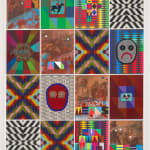Jeffrey Gibson USA, b. 1972
168.9 x 128.3 x 8.3
Further images
-
(View a larger image of thumbnail 1
)

-
(View a larger image of thumbnail 2
)

-
(View a larger image of thumbnail 3
)

-
(View a larger image of thumbnail 4
)

-
(View a larger image of thumbnail 5
)

-
(View a larger image of thumbnail 6
)

-
(View a larger image of thumbnail 7
)

-
(View a larger image of thumbnail 8
)

-
(View a larger image of thumbnail 9
)

The pastiche appearance of Gibson’s ambitious Quilt Block Paintings is a material reflection of the intertextual narratives within. Says Gibson, “My grandmothers made quilts, and I collect quilts. I’m drawn to their patchwork quality. If you know where the fabrics are coming from, there’s a story that can be played out through material culture.”
Ranging from the cartoonish, to the melodramatic, to the profane, the appropriated images in the works draw attention to inherent biases within intercultural visual narratives, such as the tendency of non-Indigenous artists to attribute dark skin tones to their perceived foes and light skin to individuals, such as Pocahontas, whom they wish to convey as friendly to colonial concerns. The works deftly interrogate differences between how Native Americans represent themselves and how they are represented by others.
Also interwoven into many of the panels are delicate, beaded objects dating from the mid-19th to mid-20th centuries. Taken from Gibson’s private collection, these items were often made for personal reasons by their intended users, and other times made as “whimseys,” so-called because of their value to tourists as objects of wonder and amusement. Incorporating traditional and global materials, these beaded objects elucidate a crucial turning point more than a century and a half ago, when sudden access to global trade allowed Native American artists to expand their visual and material lexicon. Such moments amplify awareness of Modernism not as a one-time Western phenomenon, but a continuous and manifold spectrum.








